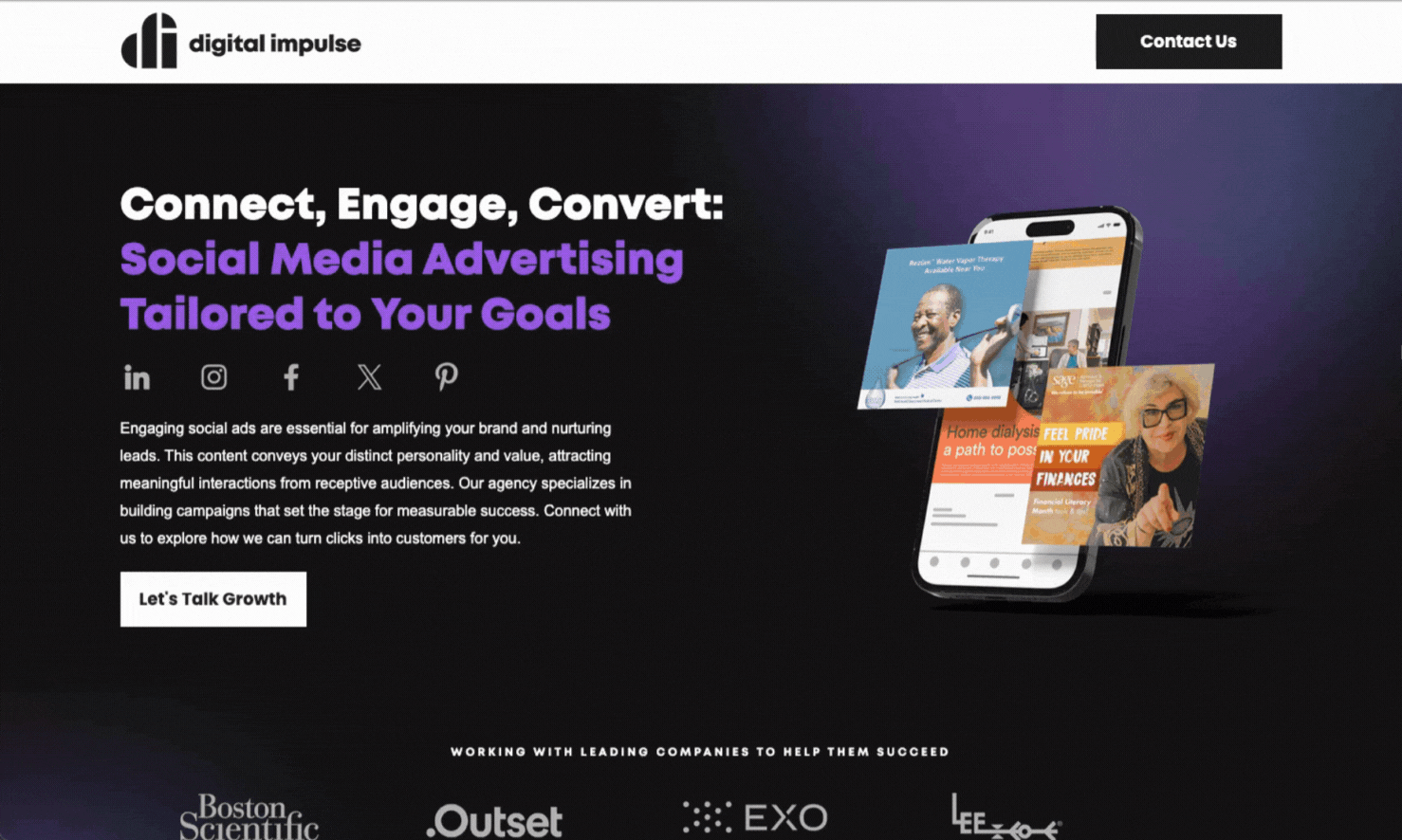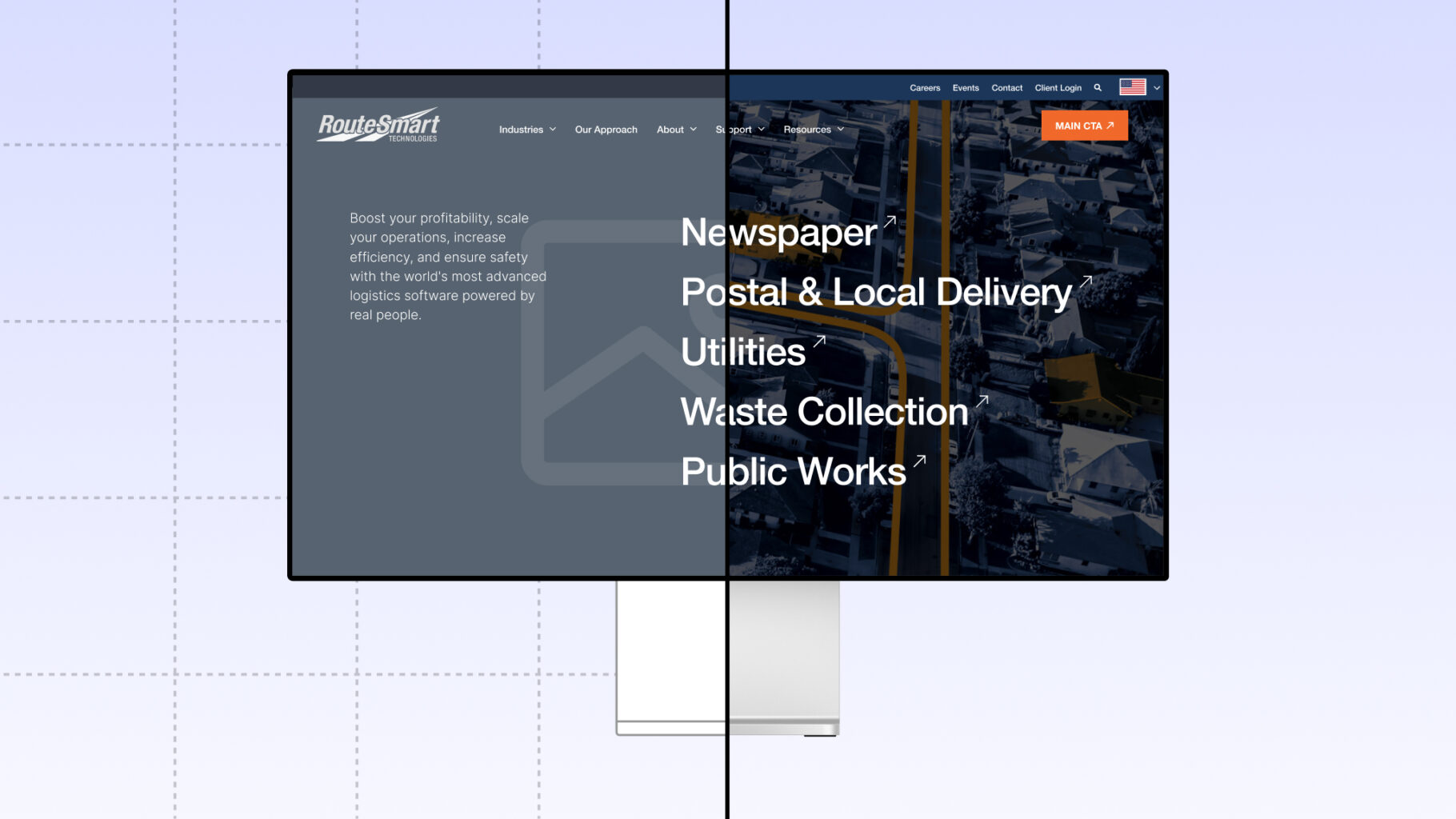A landing page is designed with a singular objective in mind: conversion. Not multiple conversion(s), as is the case with other webpages, but rather one decisive outcome. Every element is meant to concisely and persuasively guide users’ attention toward a specific decision-making juncture.
This focal point can take a variety of forms, such as a special offer, a unique call to action, a lead capture form, or a downloadable resource; essentially, any measurable user behavior you wish to encourage.
Why utilize purpose-built landing pages?
You should invest in the creation of landing pages for the cold, mathematical fact that the average conversion rate of a landing page exceeds that of a standard webpage by a compelling margin. This statistical discrepancy underscores the proven effectiveness of LPs in driving user actions and should be reason enough for any savvy marketer to give them a shot. The numbers are in, and the jury is very much not out on that point. They work. As Ron Burgundy would say, “It’s science.”
By now, enough organizations – including our agency and our clients – are experiencing success utilizing LPs that it can’t be a coincidence. That said, just because data shows that these assets are useful, doesn’t guarantee that purely by linking an LP to your ad campaign, you’ll suddenly see an eruption of conversions overnight. The landing page still has to be good.
Its headers must be topic-relevant and eye-catching; its body copy and graphic imagery must be composed and arranged to channel readers’ attention toward that decisive, action-inspiring confluence. All of this requires a bit of elbow grease. You have to think critically and creatively. If it were easy, everyone would be making money hand over fist with awesome landing pages.
Still, as we hope to prove in this blog, you absolutely can make an awesome landing page. Mastering this art is squarely within your reach. Within anyone’s reach, really. You don’t have to be a professional designer, web developer, or campaign strategist to produce high-converting content that generates leads and maximizes return on ad spend.
All it takes is a concerted effort and close adherence to a manageable set of best practices. Once you understand the essential strategies and tactics for LP construction and integration, you will see results.
What Makes a Webpage a Landing Page?
Let’s step back a moment and solidify some definitions. A landing page is, at face value, a standalone domain intentionally designed and deployed to convince a specific audience to take a specific action.
It exists and operates separately from your main site, and unlike, say, your homepage, it is not intended to appeal to everyone, just the buyer personas for whom your ad is intended. The point of a landing page is to deliver a personalized experience – a personalized version of your digital presence – to the people whose pain points and aspirations make them prime targets for whatever you’re advertising.
Your business is promoting something, and you know which segment of the consuming public will be most receptive to that offer. So, you write a series of ads and build out a landing page to tie to that campaign, the contents of which are tailor-made for and implicitly addressed to well-defined buyer personas.
The reason these purpose-built pages are so signally effective at nudging users towards conversion is that their keyword-tailored copy, topical links, and hand-picked resources are acutely relevant to one type of consumer’s wants and needs.
In this way, landing pages differ significantly from a website’s homepage or other big, broad pages because they are centered around a campaign-specific goal or value proposition and emphasize one call to action. It’s essentially a much more specialized and concise iteration of your homepage. It may look like your homepage in terms of aesthetics and branding, but it is an independent entity and not part of your main website. Visitors cannot navigate to or stumble upon an LP using dropdown menus and other links on your website; they can only access it how and when you want them to access it.
What is the True Business Value of a Landing Page?
Landing pages are crucial for revenue development because they are specifically designed to transform ad traffic into profitable leads. A well-crafted landing page does more than just capture users’ attention; it actively guides them towards conversion points and nudges them in the direction of making a decision that aligns with your business goals and contributes to your bottom line.
With targeted, personalized messaging, the LP acts as your digital salesperson, anticipating and addressing customer questions, concerns, and aspirations as they explore the page. It eliminates distractions and focuses your visitors’ attention on taking one specific action—whether that’s signing up for a free trial, downloading an exclusive guide, or purchasing your latest product. The directness of this approach enhances the effectiveness of your marketing spend by ensuring that each visitor has the highest potential to convert.
Honing the Art of Landing Page Creation: Our Best Practices
Filling in a blank canvas is never easy. Any marketer who’s been tasked with producing a landing page from scratch can attest to this. But, as they say, the only way to eat an elephant is one bite at a time. That is, even the most daunting projects become doable when you break it down into steps dictated by and carried out with the help of experienced guidance.
We construct landing pages daily, drawing upon a depth of perspective accumulated through years of trial and error. We’ve built LPs that exceed our clients’ wildest, most optimistic aspirations and we’ve built ones that fall flat on their faces. But the one thing they all have in common – the trend that ties them all together – is they’ve only gotten better over time. This experience has made us supremely confident that anyone who adheres to the same fundamental best practices for LP creation that we do can become proficient at crafting content that meets or exceeds the goals of any campaign. This brings us to our first best practice.
1. Clearly Define the Unifying Goal of the Page
Before you start designing your landing page, it’s essential to define your goal. What do you want visitors to do when they land on your page? Do you want them to sign up for a free trial, download a resource, or make a purchase?
Defining your goal will help you create a clear and focused message that will guide visitors toward taking the desired action.
2. Simplicity and Focus: The Twin Pillars Upon Which High-Impact Landing Pages Rest
The focused design and tailored content of a landing page create a seamless user experience, nudging visitors towards profitable behaviors with greater precision and reliability. By eliminating distractions and homing in on key messaging, landing pages efficiently drive conversions, making them a potent tool for maximizing marketing efforts and achieving business objectives. This streamlining is crucial given how difficult it can be to capture and maintain users’ interest.
Designing and building for short attention spans is vital. It’s why we typically recommend building campaign landing pages off-site, stripping navigation to ensure visitors don’t become distracted, and providing all the information a prospective customer might need to make their next move, so they’re not compelled to hit the back button and visit a competitor’s site for more information.
With landing pages, as with many creative endeavors, simplicity is the ultimate form of sophistication. This isn’t merely an aesthetic preference. To realize its full potential, a landing page must convey a bold and concise message, present a specific call-to-action, and minimize distractions. Above all, it’s imperative to avoid cluttering the page with excessive information or numerous offers.
3. Headlines, Copy, and Visuals Should be Immediately Relevant and Undeniably Compelling
Every word and image on your landing page needs to be intuitively and obviously relevant to the visitor’s interests. Whatever motive brought them there, you should leverage that information to craft copy that captures their attention and convinces them to act. This is not a matter of finding the prettiest words and graphics to represent and describe what you’re offering, it’s about finding the right words and graphics to effectively communicate your page’s value. What are you really trying to say? What do you really want users to know? Let this guide you in crafting benefit-oriented copy and designs that highlight the value of your offer, address their unique pain points, and appeal to their aspirations.
3. Avoid Low-Rez Pixilation Like the Plague: LP Visuals Should be of the Highest Possible Quality
Selecting suitable visuals can make or break a landing page. They don’t have to be draw-droppingly complex or colorful, just high-quality, topical, helpful, and not blurry. Graphics that are pixilated, generic, or fail to appeal to the user’s interests can result in them bouncing. Visuals that tug on the heartstrings, jump off the page, stimulate the imagination, and tie the LP’s content together thematically help make it all more engaging and persuasive. If possible, you should use only crisp, clear images that are pertinent to your offer and convey your message.
4. CTAs Should do More than Call to Action; They Should Demand and Ignite It
Make no mistake; your call-to-action (CTA) is the most critical element of your landing page. This conversion point is essentially the whole reason for the LP’s existence. Therefore, it should be intuitive, prominent (but not overly so), and aligned with your campaign’s goal. Use actionable and unique language to inspire visitors to confidently take the next step, such as filling out a form or making a purchase.
5. Keep Lead Capture Forms to a Reasonable Length
When designing the lead form for your landing page, it’s crucial to prioritize simplicity and clarity. Research suggests that longer forms tend to deter visitors from completing them. Therefore, it’s advisable to keep your form concise by only requesting essential information, such as the visitor’s name and email address. This approach enhances the likelihood of conversion, as it minimizes friction in the user experience and encourages higher completion rates. By understanding the significance of form length and content, you can optimize your landing page for maximum effectiveness in capturing leads.
6. Mobile Optimization: A Non-Negotiable Element for Landing Page Success
A large portion of your audience will be accessing the LP on their mobile devices, so it’s essential to ensure that your landing page is optimized accordingly. This means using a responsive design that adjusts to different screen sizes and ensuring that your page loads quickly on mobile devices. Most landing page builder platforms will offer mobile-specific design tools.
7. Continuous Improvement: Testing and Optimizing for Maximum Impact
Achieving optimal results with your landing page hinges on the continuous experimentation and optimization of its elements. Implement A/B testing, also referred to as split testing, wherein two versions of your landing page are created and assessed to determine the better performer.
Play around with various elements like headers, supporting copy, multimedia content, and CTAs to identify the combination that drives the highest conversions. Utilize the insights gleaned from these tests to fuel iterative improvements that will ensure your LP drives results.
Most landing page builder tools come with data analytics integrations to facilitate effective tracking and measurement. By analyzing the success of the campaign through conversion rates and other key insights, businesses can determine which of their efforts are most effective and make data-driven decisions to improve their marketing endeavors moving forward.
Examples of Our Landing Pages
Now that you know our best practices for creating an effective landing page, we must swear you to absolute secrecy. Please, stop reading, place your right hand over your heart, and repeat the following pledge:
Kidding.
To illustrate the points we’ve covered thus far, let’s look at some landing pages that we’ve built for ourselves and why they’ve been effective.
Example 1. Web Design LP

What made this landing page effective?
Start with why: We began by emphasizing the importance of a high-quality website and why it’s effective for driving business growth. This focus on practical outcomes rather than “wouldn’t it be nice to have a pretty new website,” resonates with the sort of decision-makers we’re hoping to reach; people who will have to justify their choices using sound logic and business strategy.
Above-the-fold CTAs: We include calls-to-action early on to immediately capture visitors’ attention and give them an opportunity to convert.
Proof of concept: A logo wall showcasing notable clients we’ve helped serves as evidence of our capabilities. Detailed case studies further support this and demonstrate our unique approach and values.
Unique value props: We highlight the benefits of our services, including higher conversions, and outline our step-by-step process for helping clients achieve their KPIs. We then specify that our strategies are backed by data, lending credibility and authority to our approach.
Provide multiple ways to engage: We touch on other services that we offer to regain the attention of visitors who may be less interested in web design or to upsell visitors who want more than just web design. Offering a variety of ways for users to get involved and showing that you can perform numerous functions is always a great way to maximize the number of conversions on a landing page.
Close with gusto: We end by providing further social proof in the form of a glowing testimonial from a satisfied client, demonstrating the quality of our services. Finally, we include one last lead capture form and a strong call to action, encouraging visitors to take the next step.
Example 2. Our social media marketing LP

What makes this landing page effective?
A results-oriented header: Again, we focus on benefits right from the start, telling people the outcomes they can expect to achieve rather than touting our own credentials right away. Our headline emphasizes what our clients can gain from working with us. So, instead of saying “We’re the best,” we say, “You can become the best.”
Above-the-fold CTAs: As any good LP should, we have clear calls-to-action to immediately engage visitors and lay early pathways to engagement.
Showing our work: Our logo wall showcases the brands we’ve worked with and serves as proof of concept insofar as it proves that reputable companies hire our services. This is further supplemented further down the page with detailed case studies highlighting measurable outcomes achieved by recognizable brands.
Unambiguous and unique value props: Next to the lead capture form, we have clearly defined value propositions that explain the advantage of working with us. This ensures visitors understand the benefits of what we do and why they should have us do it.
Include a human touch: We offer a more personal about us section, complete with photos of our team. This allows visitors to get to know who they’ll be working with and proves that our agency is made up of real people.
Bringing it all together: Finally, we close with a clear call to action and a rousing peroration, encouraging visitors to take the next step towards success.
Our Favorite Tools for Effortless Landing Page Creation
Creating a landing page doesn’t have to be a task reserved for those with web development or graphic design skills. Today’s marketing teams have access to a range of tools that simplify the design and launch process, allowing you to get your landing pages up and running with ease. Here’s a closer look at our top two picks:
1. Unbounce
Unbounce stands out for its user-friendly approach, making it possible for all team members to build high-converting landing pages. The platform’s intuitive drag-and-drop interface, library of ready-made templates, and built-in optimization tools allow users to quickly create sleek, professional landing pages tailored to specific goals and target audiences.
This tool also excels in mobile responsiveness—a crucial feature as many (in some cases most) visitors will access your pages via their smartphones. Designers can preview and test landing pages across various devices and screen sizes, ensuring a cohesive user experience. With integrated analytics and A/B testing features, Unbounce empowers our teams to track performance and iterate based on solid data, continuously improving the effectiveness of landing pages as the campaign progresses.
2. HubSpot
HubSpot offers a comparably smooth LP creation experience, with an intuitive editing interface and a variety of adaptable templates. Its standout feature is, naturally, the seamless integration with HubSpot CRM. This streamlines the process of capturing and managing leads directly from your landing pages and enhances your ability to engage users with personalized follow-up messages or tailored content based on their interactions. And like any top-notch tool, HubSpot includes comprehensive optimization, testing, and analytics features to help continuously refine page performance.
To sum it all up and stick the landing (page)
Landing pages play a vital role in lead generation, brand promotion, and conversion optimization for businesses. To maximize their effectiveness, the folks building these pages should adhere to the best practices elucidated in this blog and leverage the appropriate LP builder tools.
Designing and deploying landing pages isn’t necessarily complex, but it can be time-consuming, and fitting it into your overarching marketing strategy is no light lift. That’s where our team at Digital Impulse is happy to lend a hand. Or, realistically, several pairs of hands.
Leveraging our extensive expertise, we can guide you through the process of designing and deploying landing pages that align with your business goals. We can assist in everything from defining objectives to crafting compelling copy, CTAs, and ensuring mobile responsiveness. In short, our agency ensures your LPs are optimized for success. By partnering with DI, your team will have high-converting landing pages that propel your business forward. Please contact us today to begin the conversation. We genuinely love talking about LPs.





